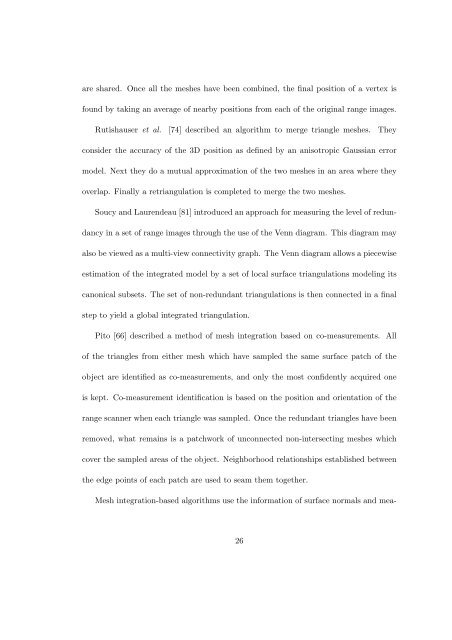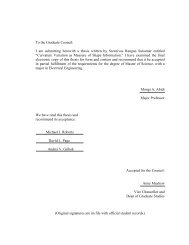To the Graduate Council: I am submitting herewith a dissertation ...
To the Graduate Council: I am submitting herewith a dissertation ...
To the Graduate Council: I am submitting herewith a dissertation ...
Create successful ePaper yourself
Turn your PDF publications into a flip-book with our unique Google optimized e-Paper software.
are shared. Once all <strong>the</strong> meshes have been combined, <strong>the</strong> final position of a vertex isfound by taking an average of nearby positions from each of <strong>the</strong> original range images.Rutishauser et al. [74] described an algorithm to merge triangle meshes. Theyconsider <strong>the</strong> accuracy of <strong>the</strong> 3D position as defined by an anisotropic Gaussian errormodel. Next <strong>the</strong>y do a mutual approximation of <strong>the</strong> two meshes in an area where <strong>the</strong>yoverlap. Finally a retriangulation is completed to merge <strong>the</strong> two meshes.Soucy and Laurendeau [81] introduced an approach for measuring <strong>the</strong> level of redundancyin a set of range images through <strong>the</strong> use of <strong>the</strong> Venn diagr<strong>am</strong>. This diagr<strong>am</strong> mayalso be viewed as a multi-view connectivity graph. The Venn diagr<strong>am</strong> allows a piecewiseestimation of <strong>the</strong> integrated model by a set of local surface triangulations modeling itscanonical subsets. The set of non-redundant triangulations is <strong>the</strong>n connected in a finalstep to yield a global integrated triangulation.Pito [66] described a method of mesh integration based on co-measurements. Allof <strong>the</strong> triangles from ei<strong>the</strong>r mesh which have s<strong>am</strong>pled <strong>the</strong> s<strong>am</strong>e surface patch of <strong>the</strong>object are identified as co-measurements, and only <strong>the</strong> most confidently acquired oneis kept. Co-measurement identification is based on <strong>the</strong> position and orientation of <strong>the</strong>range scanner when each triangle was s<strong>am</strong>pled. Once <strong>the</strong> redundant triangles have beenremoved, what remains is a patchwork of unconnected non-intersecting meshes whichcover <strong>the</strong> s<strong>am</strong>pled areas of <strong>the</strong> object. Neighborhood relationships established between<strong>the</strong> edge points of each patch are used to se<strong>am</strong> <strong>the</strong>m toge<strong>the</strong>r.Mesh integration-based algorithms use <strong>the</strong> information of surface normals and mea-26
















